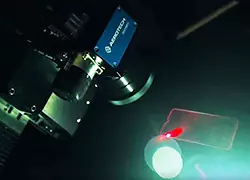What Is The Basic Principle Of A Servo Motor?
The fundamental principle of a servo motor is closed-loop feedback control. This mechanism allows the motor system to continuously measure its actual...
Work with our team to determine which products or systems are the best fit for your application.
Some Aerotech products are available for immediate order in North America through our partner Motion Plus.

A case study examining display production that optimizes quality and throughput – and lower total cost.
A servo amplifier, or servo drive, is the indispensable power electronics device that converts low-voltage command signals into the high-current flow required to drive a motor with stability and precision. The choice of amplifier architecture is a critical engineering decision, as it dictates the system's noise profile, efficiency and ultimate achievable motion quality.
This component is key to the overall performance of precision servo drives, which enable the high-fidelity movements demanded by precision motion control. The primary technical distinctions among servo amplifiers are based on their power stage design: linear or pulse width modulation (PWM).
Servo amplifiers are primarily classified into two fundamental types based on how they condition and supply power to the motor, presenting a core trade-off between motion quality and thermal efficiency.
Linear Amplifiers: These drives operate their power transistors in the linear region, delivering a continuous, ripple-free current. The result is an extremely clean output signal, which is ideal for demanding applications requiring the highest motion smoothness and nanometer-level stability such as optical inspection or ultra-precision alignment. This better performance comes at the cost of lower efficiency and lower power handling because excess power is dissipated as heat, requiring larger heat sinks.
Pulse Width Modulation (PWM) Amplifiers: These drives operate by rapidly switching power transistors fully on and off. The average current is controlled by modulating the width of the "on" pulses. This switching minimizes power loss as heat, providing high power and efficiency in a compact size. However, the high-frequency switching introduces current ripple (noise) into the motor and mechanics, which can limit servo loop bandwidth and positioning performance.
The distinction between types of servo drives is crucial for understanding their applications. Choose PWM for high power and efficiency, but opt for linear when motion purity and low noise are the absolute priorities.
Motor control modes define the specific physical parameter the servo drive or controller is actively regulating in its closed-loop feedback system, ensuring the servo motor responds to commands as intended. These modes are often hierarchical and include three primary categories:
Position Control: The system uses position feedback (from encoders or scales) to ensure the motor reaches and maintains a precise coordinate in the working space. This is the most common mode for precise automation tasks.
Velocity Control: The system uses velocity feedback to maintain a constant speed or follow a precise speed profile. It is commonly used in continuous processes like web handling or scanning.
Torque Control (Current Control): The drive regulates the current flowing into the motor to maintain a specific output force or torque, often used in force testing or advanced packaging.
Understanding linear servo motors helps in grasping these control modes, as direct-drive linear motors require highly responsive current (torque) control to handle rapid changes in the load or counter external forces, ensuring smooth motion.
The three most commonly used servo control modes are position control, velocity control and torque control. These modes operate in nested, layered loops to provide comprehensive control over the motor's dynamic behavior:
Torque Control (Innermost Loop): Ensures the motor generates the exact force commanded, closed in the drive for fastest response.
Velocity Control (Middle Loop): Ensures the motor maintains the commanded speed, using torque control as its inner loop.
Position Control (Outermost Loop): Commands the system to move to a precise coordinate. Position control is often used in applications requiring precise movement, as it is the final metric for machine performance.
The PWM amplifier is frequently used in high-throughput applications because its high-power density allows for high continuous accelerations. In contrast, the high-purity signal of a linear amplifier is often preferred for position control in noise-sensitive systems.
PWM stands for Pulse Width Modulation. A PWM amplifier is a servo drive that controls the power delivered to the motor by rapidly switching the output voltage on and off at a high frequency. The average power, which determines the motor's torque, is controlled by modulating the width of these "on" pulses (the duty cycle).
This method is highly efficient because the transistors are either fully "on" or fully "off," minimizing heat generation and allowing for smaller, more powerful drives. Its main trade-off is the high-frequency electrical noise created by the rapid switching, which can affect motion quality. When comparing linear amplifier vs. PWM amplifier, the key distinction is the trade-off: PWM is chosen for high efficiency and high power output, while linear amplification is chosen when noise and motion smoothness are the highest priorities, regardless of the thermal and size penalty.
Have questions about precision motion control? Ask our experts!
The fundamental principle of a servo motor is closed-loop feedback control. This mechanism allows the motor system to continuously measure its actual...
Precision Motion Controller A precision motion controller is the central computing engine designed specifically to meet the stringent demands of...
Galvo Laser Scan Heads In the world of precision laser material processing, speed and accuracy drive innovation and productivity. The ability to...